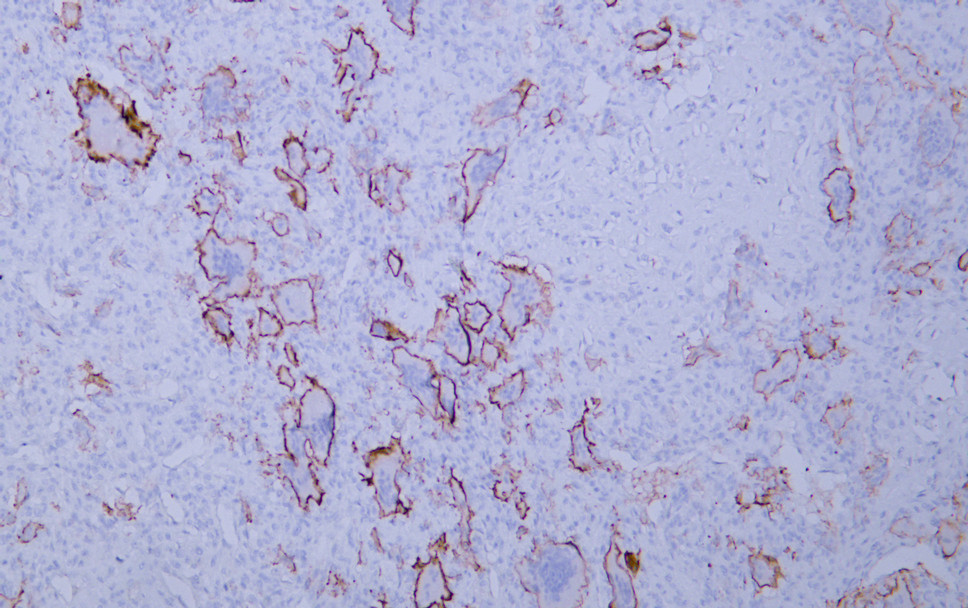CD61 (ABT032) mouse mAb
- Catalog No.:YM6117
- Applications:IHC;ELISA
- Reactivity:Human;Mouse;
- Target:
- Integrin β3
- Fields:
- >>Rap1 signaling pathway;>>Phagosome;>>PI3K-Akt signaling pathway;>>Osteoclast differentiation;>>Focal adhesion;>>ECM-receptor interaction;>>Platelet activation;>>Neutrophil extracellular trap formation;>>Hematopoietic cell lineage;>>Regulation of actin cytoskeleton;>>Thyroid hormone signaling pathway;>>Human cytomegalovirus infection;>>Human papillomavirus infection;>>Herpes simplex virus 1 infection;>>Proteoglycans in cancer;>>MicroRNAs in cancer;>>Hypertrophic cardiomyopathy;>>Arrhythmogenic right ventricular cardiomyopathy;>>Dilated cardiomyopathy;>>Fluid shear stress and atherosclerosis
- Gene Name:
- ITGB3 GP3A
- Protein Name:
- Integrin beta-3 (Platelet membrane glycoprotein IIIa) (GPIIIa) (CD antigen CD61)
- Human Gene Id:
- 3690
- Human Swiss Prot No:
- P05106
- Immunogen:
- Synthesized peptide derived from human CD61 AA range: 1-100
- Specificity:
- The antibody can specifically recognize human CD61 protein.
- Formulation:
- PBS, 50% glycerol, 0.05% Proclin 300, 0.05%BSA
- Source:
- Mouse, Monoclonal/IgG1, kappa
- Dilution:
- IHC 1:200-400. ELISA 1:500-5000
- Purification:
- The antibody was affinity-purified from ascites by affinity-chromatography using specific immunogen.
- Storage Stability:
- -15°C to -25°C/1 year(Do not lower than -25°C)
- Molecular Weight(Da):
- 87kD
- Observed Band(KD):
- 70kD
- Background:
- The ITGB3 protein product is the integrin beta chain beta 3. Integrins are integral cell-surface proteins composed of an alpha chain and a beta chain. A given chain may combine with multiple partners resulting in different integrins. Integrin beta 3 is found along with the alpha IIb chain in platelets. Integrins are known to participate in cell adhesion as well as cell-surface mediated signalling. [provided by RefSeq, Jul 2008],
- Function:
- disease:Defects in ITGB3 are a cause of Glanzmann thrombasthenia (GT) [MIM:273800]; also known as thrombasthenia of Glanzmann and Naegeli. GT is the most common inherited disease of platelets. Its inheritance is autosomal recessive. It is characterized by mucocutaneous bleeding of mild-to-moderate severity and the inability of this integrin to recognize macromolecular or synthetic peptide ligands. GT has been classified clinically into types I and II. In type I, platelets show absence of the glycoprotein IIb-IIIa complexes at their surface and lack fibrinogen and clot retraction capability. In type II, the platelets express the GPIIb-IIIa complex at reduced levels (5-20% controls), have detectable amounts of fibrinogen, and have low or moderate clot retraction capability. The platelets of GT variants have normal or near normal (60-100%) expression of dysfunctional receptors.,function:Int
- Subcellular Location:
- Cytoplasmic
- Expression:
- Isoform beta-3A and isoform beta-3C are widely expressed. Isoform beta-3A is specifically expressed in osteoblast cells; isoform beta-3C is specifically expressed in prostate and testis.
- June 19-2018
- WESTERN IMMUNOBLOTTING PROTOCOL
- June 19-2018
- IMMUNOHISTOCHEMISTRY-PARAFFIN PROTOCOL
- June 19-2018
- IMMUNOFLUORESCENCE PROTOCOL
- September 08-2020
- FLOW-CYTOMEYRT-PROTOCOL
- May 20-2022
- Cell-Based ELISA│解您多样本WB检测之困扰
- July 13-2018
- CELL-BASED-ELISA-PROTOCOL-FOR-ACETYL-PROTEIN
- July 13-2018
- CELL-BASED-ELISA-PROTOCOL-FOR-PHOSPHO-PROTEIN
- July 13-2018
- Antibody-FAQs
- Products Images

- Human giant cell tumor tissue was stained with Anti-CD61 (ABT032) Antibody

- Human tonsil tissue was stained with Anti-CD61 (ABT032) Antibody



